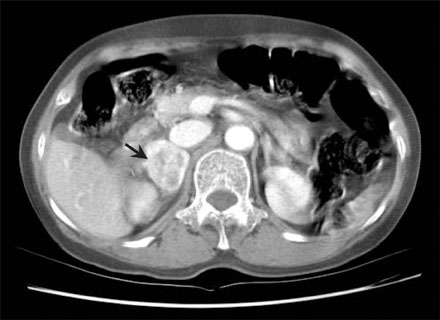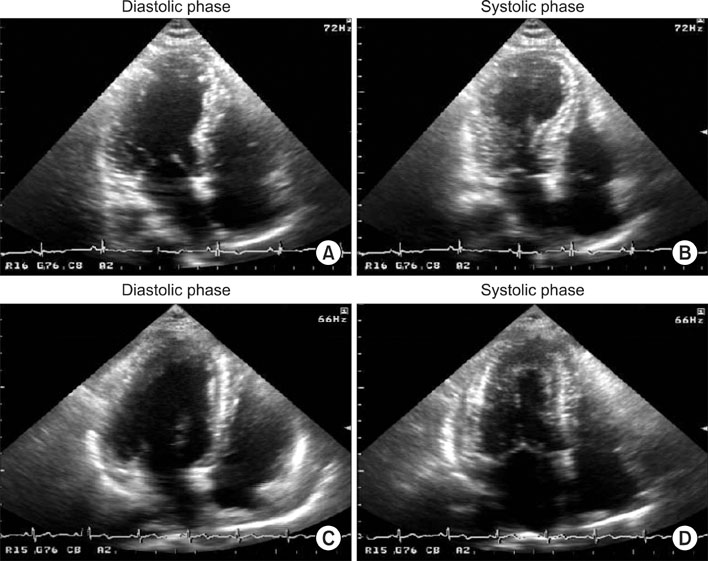Tuberc Respir Dis.
2008 Mar;64(3):219-223. 10.4046/trd.2008.64.3.219.
A Case of Pheochromocytoma Accompanied with Alveolar Hemorrhage and Cardiogenic Pulmonary Edema
- Affiliations
-
- 1Department of Internal Medicine, Gwangju Christian Hospital, Korea.
- 2Department of Pulmonary and Critical Care Medicine, Chonnam National University Medical School, Korea. droij@chonnam.ac.kr
- 3Department of Internal Medicine, Miraero21 Hospital, Gwangju, Korea.
- 4Department of Internal Medicine, Seonam University College of Medicine, Namwon, Korea.
- KMID: 1478185
- DOI: http://doi.org/10.4046/trd.2008.64.3.219
Abstract
- Pheochromocytoma is derived from the chromaffin tissue. The typical finding of pheochromocytoma is paroxysmal hypertension accompanied with various signs and symptoms that are due to the excess of catecholamines or other bioactive substances. Yet the diagnosis is sometimes difficult to make because its clinical presentation is quite variable. Especially, hemoptysis is a very rare symptom, so the diagnosis is often missed or delayed. Without making the correct diagnosis and then subsequently administering treatment, the condition may be fatal. We herein report on a 68 year-old woman who was admitted because of abdominal pain and hemoptysis. The initial radiologic findings suggested pulmonary edema with alveolar hemorrhage. The urine catecholamine levels were elevated and she developed catecholamine-induced cardiomyopathy. We performed bronchial arterial embolization and we administered alpha blocker medication for controlling the hemoptysis and hypertension. After the temporary symptomatic improvement, her clinical course was aggravated by pneumonia and pulmonary edema. In spite of performing definitive surgery for pheochromocytoma, she died of postoperative hemodynamic instability.
MeSH Terms
Figure
Reference
-
1. Kizer JR, Koniaris LS, Edelman JD, St John Sutton MG. Pheochrocytoma crisis, cardiomyopathy, and hemodynamic collapse. Chest. 2000. 118:1221–1223.2. Wu GY, Doshi AA, Haas GJ. Pheochromocytoma induced cardiogenic shock with rapid recovery of ventricular function. Eur J Heart Fail. 2007. 9:212–214.3. Frymoyer PA, Anderson GH Jr, Blair DC. Hemoptysis as a presenting symptom of pheochromocytoma. J Clin Hypertens. 1986. 2:65–67.4. Jung YS, Kim JG, Song SK, Kwon SK, Choi YS, Jang TW, et al. A case of pheochromocytoma accompanied with hemoptysis. Kosin Med J. 2000. 15:103–107.5. Iino S, Nagashima N, Akiba H, Ban Ymiyamoto M. Hemoptysis and palpitation (with hypertension): pheochromocytoma. Nippon Rinsho. 1975. Spec No:918–919. 1394–1395.6. Joshi R, Manni A. Pheochromocytoma manifested as noncardiogenic pulmonary edema. South Med J. 1993. 86:826–828.7. Takeshita T, Shima H, Oishi S, Machida N, Uchiyama K. Noncardiogenic pulmonary edema as the first manifestation of pheochromocytoma. Radiat Med. 2005. 23:133–138.8. Gatzoulis KA, Tolis G, Theopistou A, Gialafos JH, Toutouzas PK. Cardiomyopathy due to a pheochromocytoma. A reversible entity. Acta Cardiol. 1998. 53:227–229.9. Minno AM, Bennett WA, Kvale WF. Pheochromocytoma: a study of 15 cases diagnosed at autopsy. N Engl J Med. 1954. 251:959–965.10. de Graeff , Muller H, Moolenaar AJ. Pheochromocytoma: a report of seven cases. Acta Med Scand. 1959. 164:419–430.11. Kimura Y, Ozawa H, Igarashi M, Iwamoto T, Nishiya K, Urano T, et al. A pheochromocytoma causing limited coagulopathy with hemoptysis. Tokai J Exp Clin Med. 2005. 30:35–39.
- Full Text Links
- Actions
-
Cited
- CITED
-
- Close
- Share
- Similar articles
-
- Unilateral pulmonary edema during an operation in patient with undiagnosed pheochromocytoma: A case report
- A Case of Pheochromocytoma Presented with Cardiogenic Shock and Followed by Spontaneous Remission
- Sodium nitroprusside on acute cardiogenic pulmonary edema in dogs: case reports
- Neurogenic Pulmonary Edema Occured during the Brain Tumor Surgery - A case report
- A case of diffuse alveolar hemorrhage with thoracocervicofacial purpura after a generalized tonic-clonic seizure





